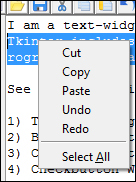In this last iteration, we will add the following features to our editor:
- Event handling
- The context menu
- The title bar icon
Let us complete our editor in this final iteration.
- First we will add the event handling features. We have added the accelerator keyboard shortcuts to a large number of our menu items. However, merely adding accelerator keys does not add the required functionality. For example, pressing the keys Ctrl + N should create a new file, but simply adding it as an accelerator does not make it functional. Let's add these event handling features into our code.
textPad.bind('<Control-N>', new_file) textPad.bind('<Control-n>', new_file) textPad.bind('<Control-O>', open_file) textPad.bind('<Control-o>', open_file) textPad.bind('<Control-S>', save) textPad.bind('<Control-s>', save) textPad.bind('<Control-A>', select_all) textPad.bind('<Control-a>', select_all) textPad.bind('<Control-f>', on_find) textPad.bind('<Control-F>', on_find) textPad.bind('<KeyPress-F1>', help_box)Note
Simply adding these lines takes care of our event bindings. However, this introduces a new issue for us. We have already discussed that event bindings pass the event object as a parameter to the bound callback. None of our previous functions are equipped to handle the incoming parameters. To do that we need to add the
event=Noneparameter.Adding this optional argument allows us to use these functions with or without the event parameter.
Alternatively, you can also add
textPad.bind (event, lambda e: callback())to ignore theeventargument altogether.Now you can access these functions using your keyboard shortcuts.
Note that we did not bind keyboard shortcuts for cut, copy, and paste. This is because the Text widget comes with automatic binding for these events. If you add bindings for these events, it will cause cut, copy, and paste events to take place twice; once from the built-in widget and once from your own defined event handler.
- Next we will add the context menu. But before that, we need to understand what a context menu is.
The menu that pops up on the right-mouse-button click at the location of the mouse cursor is called the context menu or the o. This is shown in the following screenshot:

Let's code this feature in our text editor. We first define our context menu:
cmenu = Menu(textPad) for i in ('cut', 'copy', 'paste', 'undo', 'redo'): cmd = eval(i) cmenu.add_command(label=i, compound=LEFT, command=cmd) cmenu.add_separator() cmenu.add_command(label='Select All', underline=7, command=select_all)We then bind the right-click of a mouse with a callback named
popup:textPad.bind("<Button-3>", popup)Finally, we define the method
popup:def popup(event): cmenu.tk_popup(event.x_root, event.y_root, 0) - As a final touch to our application, we add a title bar icon for our editor using the following code:
root.iconbitmap('icons/pypad.ico')
